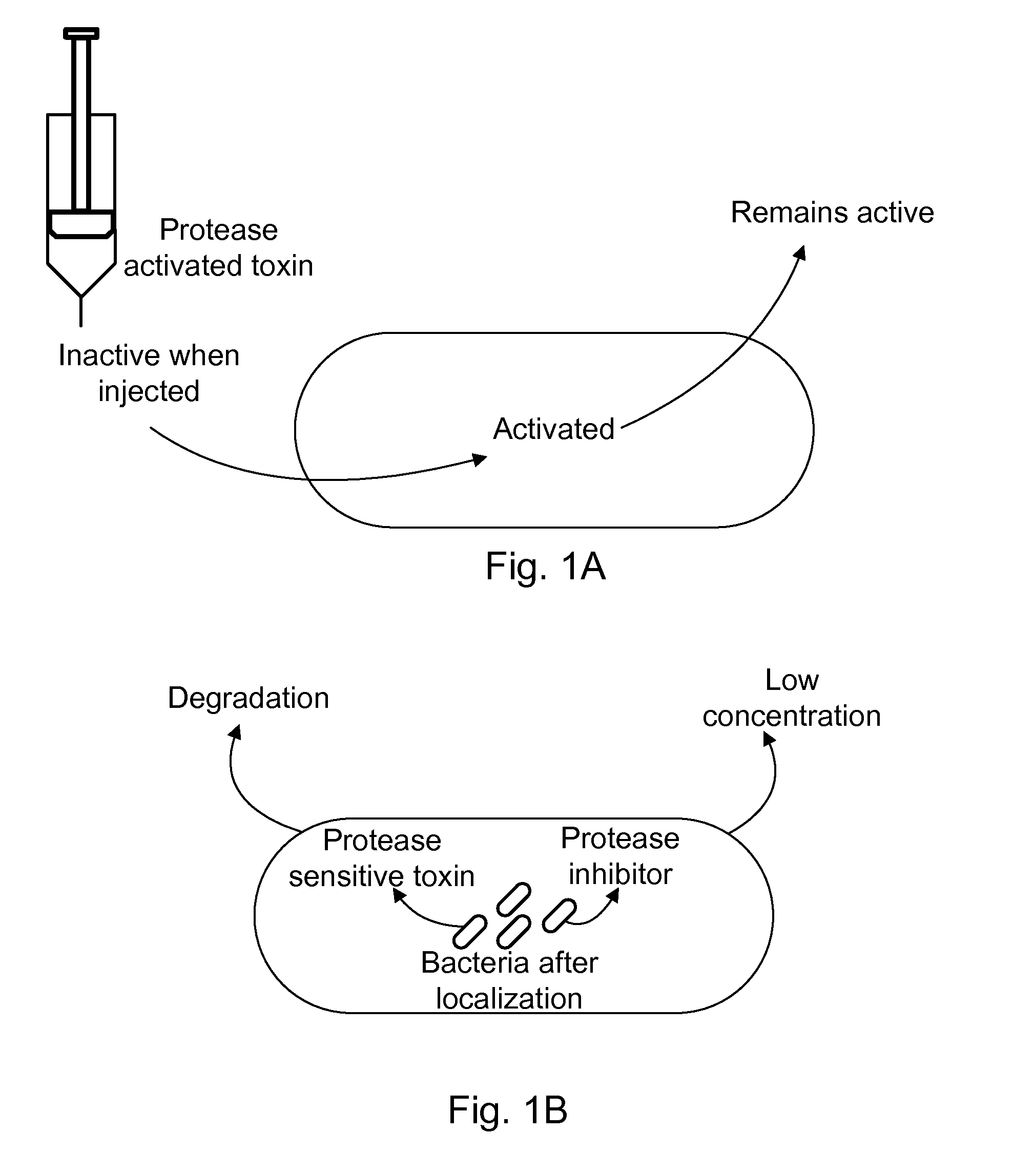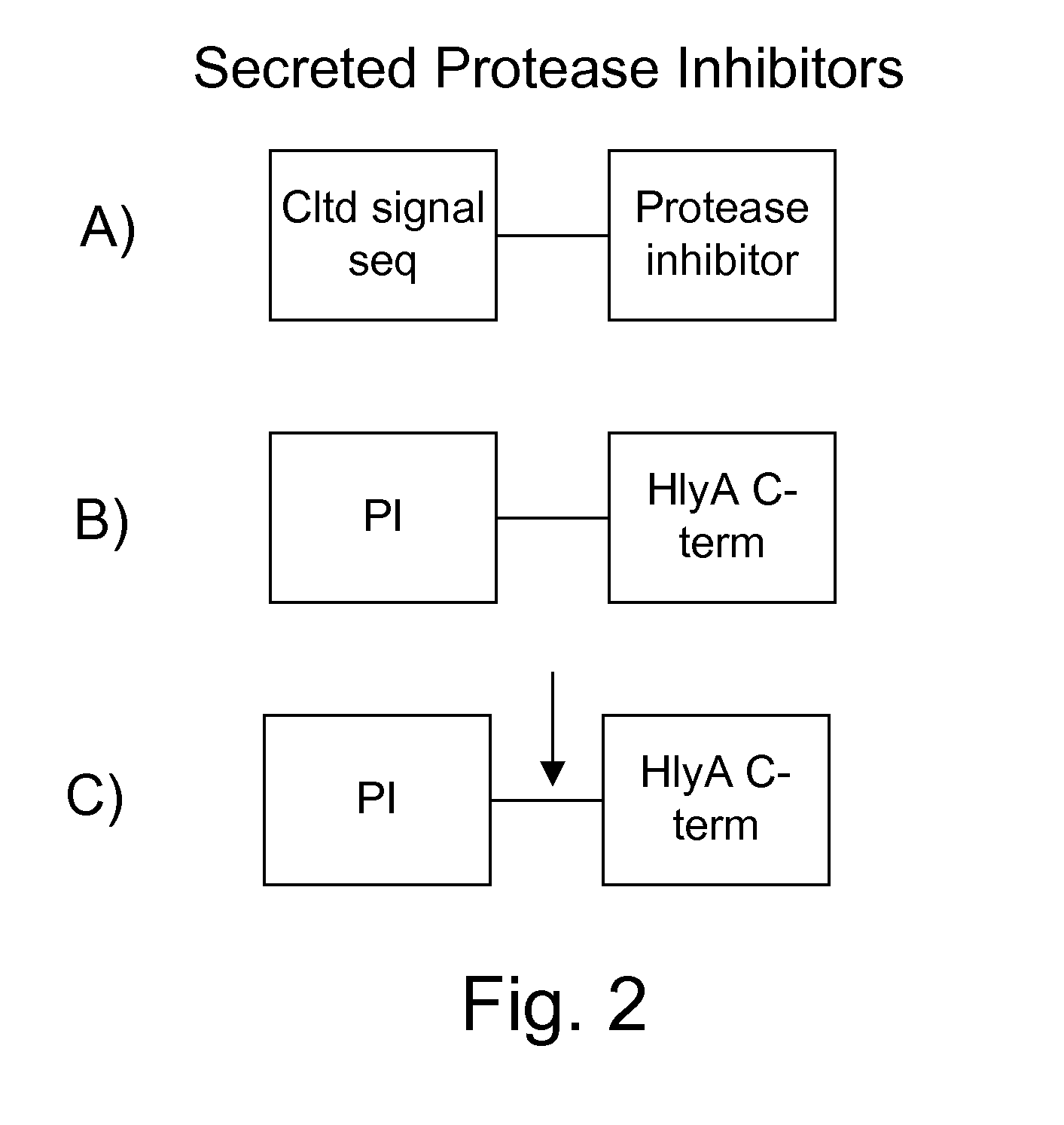Protease sensitivity expression system
a technology of protease and expression system, applied in the field of therapeutic delivery systems, can solve problems such as limiting known forms of genetic exchange, and achieve the effects of increasing activity, preventing the destruction of therapeutic molecule, and expanding tumor zon
- Summary
- Abstract
- Description
- Claims
- Application Information
AI Technical Summary
Benefits of technology
Problems solved by technology
Method used
Image
Examples
example 1
8.1. Example 1
Secreted Protease Inhibitors
[0118]Secreted protease inhibitors are generated using standard molecular genetic techniques and expressed in bacteria using methods known to those skilled in the arts, operably linking a promoter, ribosomal binding site and initiating methionine if not provided by the first portion of the construct. The construct may either be a plasmid or a chromosomal integration vector, for which many different integration sites exist, including but not limited to any of the attenuation mutations or any of the IS200 elements. The constructs may also be polycistronic, having multiple genes and / or gene products separated by ribosomal binding sites. The different forms of the protease inhibitor constructs are shown in FIG. 2. The constructs used have three basic forms: 1) An N-terminal signal sequence, such as that from M13pIII MKKLLFAIPLVVPFYSHS SEQ ID NO:44, followed by a protease inhibitor such as the furin inhibitor GKRPRAKRA; 2) a protease inhibitor su...
example 2
8.2 Example 2
A Targeted Colicin E3 (Cole3) Chimera
[0119]First, the colicin colE3 immunity protein is synthesized as an expression cassette and cloned into a chromosomal localization vector for an integration site distal to the that of the chimeric effector gene vector described below, e.g., an IS200 deletion vector at location. The amino acid sequence of the immunity protein is given as:
MGLKLDLTWFDKSTEDFKGEEYSKDFGDDGSVMESLGVPFKDNVNNGCFDVIAEWVP LLQPYFNHQIDISDNEYFVSFDYRDGDW SEQ ID NO:49
[0120]The sequence is reverse translated using codons optimal for Salmonella. The entire chimeric effector protein and expression cassette components are synthesized using standard DNA synthesis techniques at a contract DNA synthesis facility and integrated into the chromosome (Donnenberg and Kaper, 1991, Low et al., 2003, each of which is expressly incorporated herein by reference). The recipient stain can be any tumor-targeted gram-negative bacterium.
[0121]This example follows the chimeric pattern sho...
example 3
8.3 Example 3
A Targeted Colicin Chimera Containing a Lytic Peptide Resulting in Endosomal Release and / or Increased Anti-Cancer Cell Cytotoxicity
[0124]The lytic peptide PSM-alpha-3 is inserted between the pIII signal sequence and the TGF-alpha (FIG. 3B). The complete sequence of the construct is as follows:
[0125]MKKLLFAIPLVVPFYSHSAMEFVAKLFKFFKDLLGKFLGNN VVSHFNDCPDSHTQFCFHGTCRFLVQEDKPACVCHSGYVGARCEHADLLAAETVESCL AKSHTENSFTNVWKDDKTLDRYANYEGCLWNATGVVVCTGDETQCYGTWVPIGLAIP ENEGGGSEGGGSEGGGS EGGGTKPPEYGDTPIPGYTYINPLDGTYPPGTEQNPANPNPSL EESQPLNTFMFQNNRFRNRQGALTVYTGTVTQGTDPVKTYYQYTPVSSKAMYDAYWN GKFRDCAFHSGFNEDLFVCEYQGQSSDLPQPPVNAGGGSGGGSGGGSEGGGSEGGGSE GGGSEGGGSGGGSGSGDFDYEKMANANKGAMTENADENALQSDAKGKLDSVATDYG AAIDGFIGDVSGLANGNGATGDFAGSNSQMAQVGDGDNSPLMNNFRQYLPSLPQSVEC RFAHDPMAGGHRMWQMAGLKAQRAQTDVNNKQAAFDAAAKEKSDADAALSSAMES RKKKEDKKRSAENNLNDEKNKPRKGFKDYGHDYHPAPKTENIKGLGDLKPGIPKTPKQ NGGGKRKRWTGDKGRKIYEWDS QHGELEGYRASDGQHLGSFDPKTGNQLKGPDPKRN IKKYL SEQ ID NO:51
PUM
| Property | Measurement | Unit |
|---|---|---|
| Volume | aaaaa | aaaaa |
| Volume | aaaaa | aaaaa |
| Interference | aaaaa | aaaaa |
Abstract
Description
Claims
Application Information
 Login to View More
Login to View More - R&D
- Intellectual Property
- Life Sciences
- Materials
- Tech Scout
- Unparalleled Data Quality
- Higher Quality Content
- 60% Fewer Hallucinations
Browse by: Latest US Patents, China's latest patents, Technical Efficacy Thesaurus, Application Domain, Technology Topic, Popular Technical Reports.
© 2025 PatSnap. All rights reserved.Legal|Privacy policy|Modern Slavery Act Transparency Statement|Sitemap|About US| Contact US: help@patsnap.com



